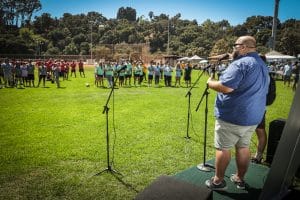BY SAM WATERSTONE | LEER EN ESPAÑOL
In 2015, Kyli Larson, a Westmont student and intern for SB ACT (then known as Uffizi Order), started asking about efforts to address human trafficking in Santa Barbara County. What she found through her research was that human trafficking was much more prevalent in our county than most people realized. She also discovered that while there were groups working to prevent trafficking, support and house survivors, and educate the public about this very real issue, these groups were isolated and disconnected.

This discovery provided a natural opportunity for SB ACT to get involved in the fight against human trafficking. SB ACT (which stands for the Santa Barbara Alliance for Community Transformation) is a “backbone organization” that uses the Collective Impact Model to eliminate disorder and confusion among like-minded organizations in order to align ideas, goals and actions behind a common cause. In this case, they partnered with the Human Trafficking Task Force, which was initiated by the Santa Barbara County District Attorney’s (DA) Office in 2013, to make a greater collective impact in regards to human trafficking.
The first stage of the collaboration was to collect reliable data. As part of Kyli’s internship with SB ACT, she worked with partners from UCSB’s Gevirtz School of Graduate Education and the DA’s Office to help create a Needs Assessment of Domestic Child Sex Trafficking in Santa Barbara County. The Needs Assessment project brought together a group of motivated organizations, including the Santa Barbara Foundation, social service providers, and law enforcement, and ultimately revealed several valuable insights.
“The Needs Assessment highlighted where the gaps were within our county for child survivors of human trafficking,” said Rich Sander, Executive Director of SB ACT. “At the time of the Assessment there were 45 confirmed child survivors of domestic sex trafficking and 80 suspected survivors. Now those numbers have risen to about 150 highly suspected or confirmed survivors, including both minors and adults. Those are only the ones in Juvenile Hall or that have become known to Victim Witness or Rape Crisis programs, so in reality the number is much larger.”
The study found that trafficking statistics are chronically underreported, and that the general public lacks even a basic understanding of the issue. As a result, there are a number of pervasive myths that surround human trafficking.
One common misunderstanding involves the relationship between child sex trafficking and prostitution. The media (and by extension the public) tends to view child sex trafficking as an egregious crime and prostitution as a less harmful, if not entirely unrelated social issue. In reality, many sex workers are victims of child sex trafficking who have since turned 18, but are still trapped in a sex trafficking operation – yet they are often viewed as criminals in the eyes of the law and the community. Similarly, relationship violence and abuse can also lead to trafficking, but might not be identified as such.

“We’re all learning about this as a county, together,” acknowledged Sander. “Like how you identify a survivor – a lot of them aren’t identified as such, because a lot of trafficking happens between couples. People may think, ‘Oh that’s just how my boyfriend treats me,’ and then we have to help them understand that it isn’t a normal thing.”
In 2016, SB ACT partnered with the DA’s Office again to form a countywide Collaborative on Human Trafficking that would supplement the work already being done by the Task Force. That group, which is now known as the Santa Barbara Coalition for Freedom, brought about a public face for trafficking.
“The DA’s Task Force is the hub for law enforcement, behavioral wellness providers, etc.,” said Jeff Shaffer, Director of Initiatives at SB ACT, explaining the dynamics of the relationship. “We developed the SB Coalition for Freedom to come alongside the Task Force and fill in the gaps.”
One gap that the Coalition fills involves education: many organizations had been providing human trafficking training to the community, including the DA’s Office, SB ACT, the Junior League of Santa Barbara, Standing Together to End Sexual Assault, and others, but it was unclear who these trainings were reaching and if they were effective. The Coalition is currently coordinating a more efficient system for educating the public about what trafficking looks like.
This education initiative now focuses on providing unduplicated training for groups who may be in a position to identify trafficking, such as bars or hotels where suspected trafficking may happen, as well as first responders, probation officers, and domestic violence service providers. It also aims to create a common language about trafficking that is based on compassion and respect.
“We don’t use the word victim – we choose to use ‘survivor’ because it is more empowering language,” explained Sander. “We want young women and men to understand that they are not passive victims of something that has happened to them, but rather that they’ve endured to survive a horrible situation.”
The SB Coalition for Freedom is providing a Human Trafficking Training 101 course for the Santa Barbara Foundation staff in August, and we encourage all organizations in the community to take advantage of this service to learn more about this issue.
To learn more about SB ACT, the SB Coalition for Freedom and their work around human trafficking, visit SBACT.org.